The Japanese Yen is the official currency of Japan. The yen was officially adopted by the Meiji government of Japan through a law signed on May 10, 1871. The yen is the third busiest currency in the world foreign exchange market after the US dollar and the euro.
The symbol for the Japanese yen is “¥” and its ISO 4217 code is JPY. In Japanese, yen is pronounced “en” and comes to mean “round object.”
The euro yen exchange (the one you will find if you buy or pay as an individual in Japan) will be around 145 yen per euro. That is to say that 1000 yen would be equivalent to about 7 euros as of the date of this update.
Specifically, as of the date of this post (2nd March 2023):
- 1 euro = 145.05 yen
- 1000 yen = 6.89 euros
History of the Japanese yen
During the 18th and 19th centuries, the Spanish silver dollar circulated throughout Asia, including Japan and China. The Manila galleons brought gold coins from America, mainly from Mexico, where they were minted.
But from 1840 the gold coins were replaced by silver coins of eight reales or one peso.
In the second half of the 19th century, local coins such as the Hong Kong dollar were minted, but since they were not adopted by Chinese merchants, who preferred the usual eight-real Mexican coins, the Hong Kong government stopped minting currency, selling the presses of coins and other machinery to Japan.
It was at this time that the Japanese authorities decided to start minting their own silver dollar coins under the name “yen” (“round object“). The “New Currency Law” of 1871 stipulated the adoption of a decimal system of calculation in which a yen was divided into 100 sen and 1000 rin, with round coins as in the West.
Subsequently, the sen and the rin were eliminated in 1953 due to their low monetary value.
During the early 1970s, before the 1973 energy crisis, the yen was a strong currency. But this strength against other world currencies made the country’s exports more expensive. For this reason the Japanese government intervened regularly in the foreign exchange market (buying or selling dollars).
But in the first half of the 1980s, the yen fell sharply in value, at a time when interest rates were higher in the US than in Japan.
At present, the yen is still a strong currency against the dollar, which makes it difficult to export from Japan abroad. Japan has been experiencing a complex situation of low economic growth for years due to its weak domestic demand.
In fact, economists remind us that in the last 20 years Japan’s PIM has only broken the 2% annual growth barrier three times. Furthermore, its relations with South Korea are not the best, despite being its natural trading partner.
At the bottom of this disagreement, the Koreans apologized to Japan, a consequence of the Japanese invasion of the Koreans in the first half of the 20th century.
Despite the bilateral cooperation agreements of 1956, which put an end to the disagreements between these two neighbors, in 2019 the Supreme Court of South Korea authorized its citizens to request economic reparations for the abuses committed by the Japanese during their occupation. from Korea.
Japanese yen coins
Circulating yen notes and coins are issued by the Bank of Japan (link to circulating ones) known as Nippon Ginko.
Coins today have denominations of:
- 500 yen.
- 100 yen.
- 50 yen.
- 10 yen.
- 5 yen.
- 1 yen.
Their shapes and edges are differentiated to help visually impaired people know the type of coin they are handling.
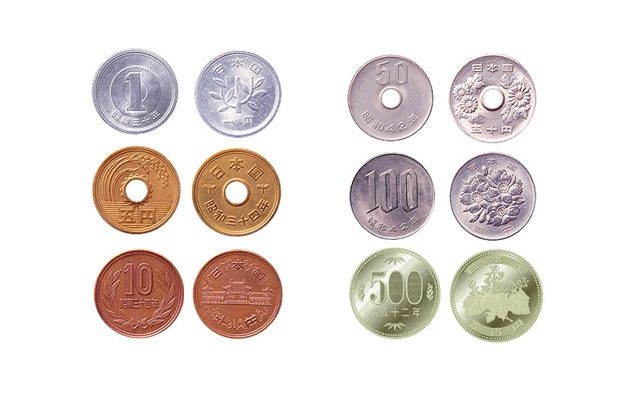
As a curiosity, it must be said that the yen coins do not show the minting date. Instead they show the regnal year of the Emperor at the time of minting.
That is, a coin minted in 2009 would bear the date Heisei 21 (“21st year of Emperor Akihito’s reign”).
One Japanese yen coin
The one yen (¥1) coin measures 20 mm in diameter 20 mm and weighs 1 gram. It is made of aluminum.
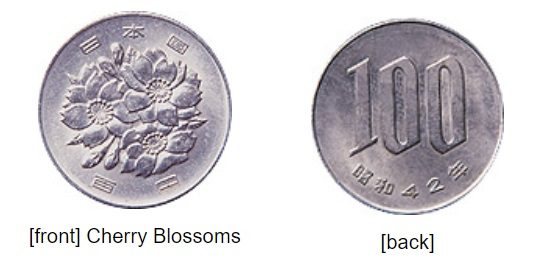
Five Japanese yen coin
The five yen (¥5) coin has a diameter of 22 mm and weighs 3.75 grams. It is golden in color since it is made of an alloy of copper and zinc. It has a round hole in the center and a drawing of a rice plant on the front.
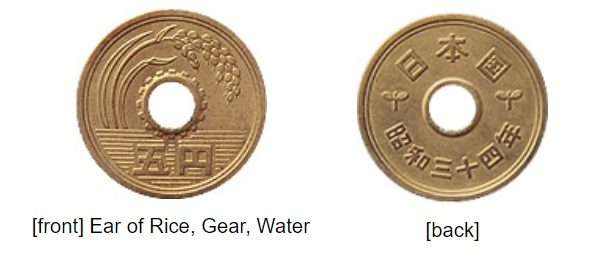
Ten Japanese yen coin
The ten yen (¥10) coin measures 23.5 mm in diameter and weighs 4.5 grams. It is very easy to recognize by its tan color, since the main material with which it is made is copper. On the obverse appears the Byodo-in temple in Kyoto, the same one found on the ¥10,000 note.
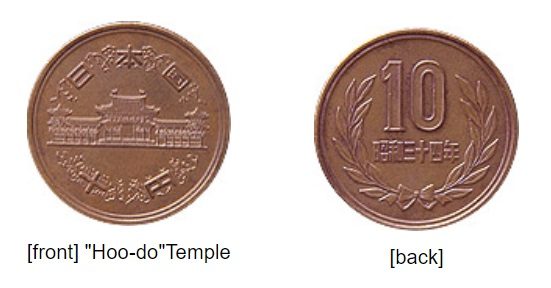
Fifty Japanese yen coin
The fifty yen (¥50) coin has a diameter of 21 mm and weighs 4 grams. It is silver in color and made of cupronickel. Like the ¥5 coin, this one is also holed in the center.
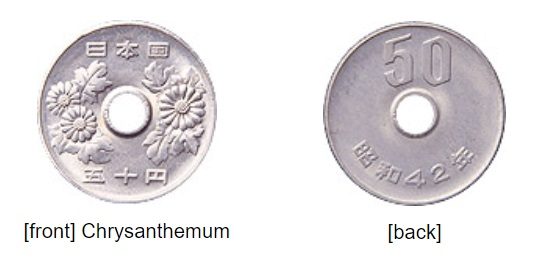
One hundred Japanese yen coin
The one hundred yen (¥100) coin has a diameter of 22.6 mm and weighs 4.8 grams. It is a silver coin, made of cupronickel. It is adorned with cherry blossom.
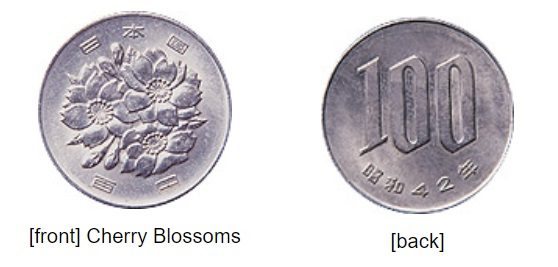
Five hundred Japanese yen coin
The five hundred yen (¥500) coin has a diameter of 26.5 mm and weighs 7 grams. It is the most abundant and used currency in Japan. On the obverse are a bamboo plant and a mandarin blossom.
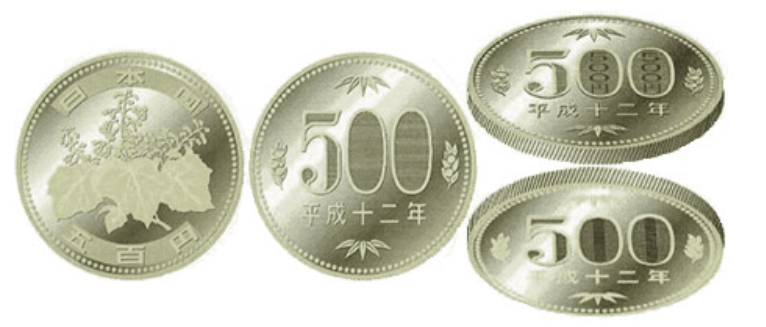
Japanese yen banknotes
The yen notes in circulation today have denominations of 10,000, 5,000, 2,000, and 1,000 yen respectively. They are printed by the Japanese Stamp Factory (National Printing Bureau) at the request of the issuer, the Central Bank (Nippon Ginko).
At the end of 2019, the amount of banknotes in circulation in Japan held by households, companies and financial institutions was 112.7 trillion yen (17.3 billion banknotes).
If these banknotes were stacked in the shape of a mountain, they would reach a height of approximately 1,731 kilometers, equivalent to 458 times the height of Mount Fuji (3,776 meters).
If placed side by side, the banknotes would reach a length of around 2.69 million kilometers, enough to circle the globe some 67 times, or seven times the distance from the earth to the moon.
Let’s look at each of these banknotes below.
Japanese 10,000 yen banknote
The 10,000 yen banknote is in shades of brown and beige. It was first issued on November 1, 2004. Its obverse is dedicated to Yukichi Fukuzawa (1835-1901), a late-19th-century Japanese writer, teacher, and politician.
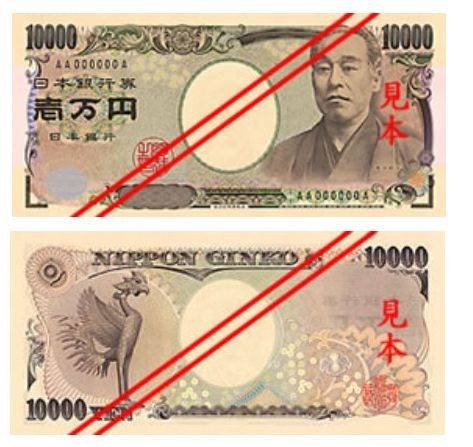
His ideas about government were supported by his knowledge of Western political theory. The political teachings of his books served to modernize a still feudal Japan in his time. Since his death in 1901, Fukuzawa has been credited with being one of the founders of modern Japan and one of the leaders of the Meiji Enlightenment movement.
The reverse shows a phoenix from the Buddhist Byodoin Temple (Byōdō-in) established in the year 998 in the city of Uji, Kyoto Prefecture.
The equivalent value in euros of the ten thousand yen banknote would be about 80 euros today.
Japanese 5,000 yen banknote
The 5,000 yen banknote is in shades of brown and purple. It was first aired as well on November 1, 2004.
Its obverse is dedicated to Ichiyō Higuchi (1872-1896), a famous Japanese writer specializing in novels (Otsugomori -1894; Yukukumo -1895; Nigorie and Jūsan’ya-1895 and Takekurabe in 1896). Her birth name was Natsuko Higuchi, which is why she was also known by the pseudonym Natsu Higuchi.
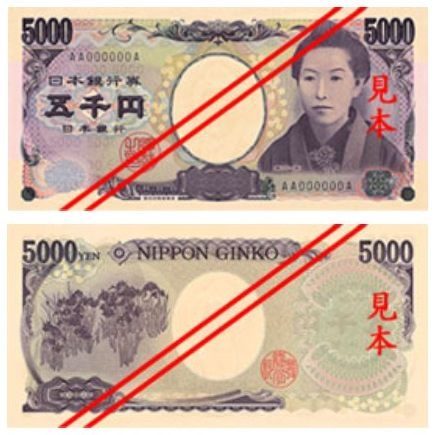
The reverse of this note shows the iris painting “Kakitsubata-zu” by the artist Ōgata Kōrin (1658-1716) of the Rinpa school of Japanese painting. Kōrin is known for his spectacular lacquered screens.
The equivalent value in euros of the five thousand yen banknote would be about 40 euros today.
Japanese 2,000 yen banknote
The 2,000 yen banknote is in shades of green and beige. It was first issued on July 19, 2000. Its obverse is dedicated to the Shureimon gate.
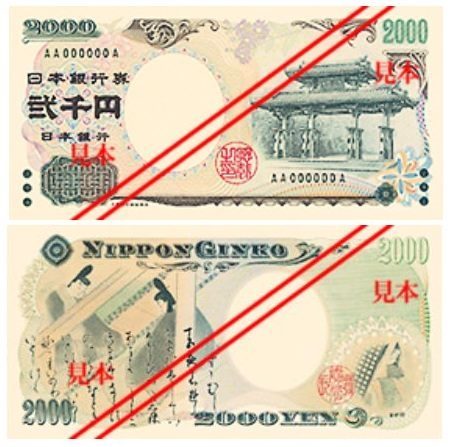
Shureimon is one of the two great gates of Shuri Castle in Naha, Okinawa Prefecture. Its origins date back to the 16th century. The structure of this gate is similar to that of the three-tiered Chinese gates and is covered by reddish tiles.
The gate was destroyed in 1945 during the Battle of Okinawa and rebuilt through local fundraising in the 1950s and 1960s. It became the first part of Shuri Castle to be rebuilt, which took a few more decades to restore to its original appearance.
On the back is a scene from the tale of Genji and the portrait of its author, the writer Murasaki Shikibu (970-1016). Shikibu is credited with the first Japanese novel (Genji Monogatari) and also the world’s first modern novel.
The equivalent value in euros of the two thousand yen banknote would be about 16 euros today.
Japanese 1,000 yen banknote
The 1,000 yen banknote is in shades of purple and beige. It was also first issued on November 1, 2004 as the 10,000 and 5,000 yen notes.
Its obverse is dedicated to Hideyo Noguchi (1876-1928), a Japanese doctor specializing in the study of bacteria who discovered the pathogen of neurosyphilis in 1913.
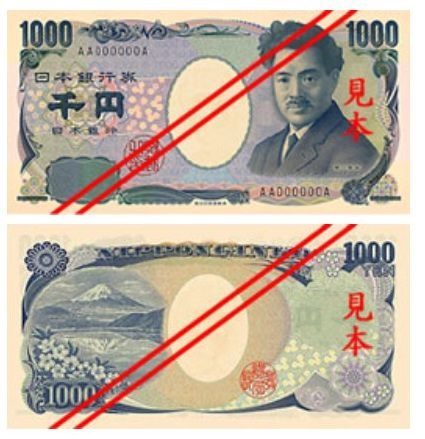
The reverse of this banknote shows Mount Fuji with some cherry blossoms. Mount Fuji (3,776 meters above sea level) is the highest peak on the island of Honshu and in all of Japan. On clear days it can be easily seen from Tokyo itself. Fuji is the national symbol of Japan.
The equivalent value in euros of the thousand yen banknote today would be about 8 euros.
Euro to yen rate
The change of the euro against the Japanese yen oscillates at all times. If you search Google for “euro-Japanese yen exchange” you will find dozens of websites (currency converters) that offer a “rate” of the day, even with Google Finance prices.
Something like this (March 2, 2023):
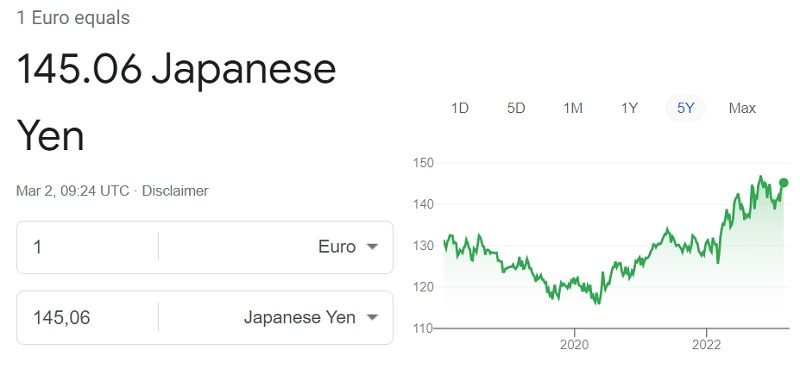
As you can see, the change over the last five years has fluctuated between 118 and 148 yen per euro, but keep in mind that this graph represents the value of the yen “currency” against the euro, and not the currency, which is lower.
In fact, at currency suppliers in France you can buy Japanese yen at an exchange rate of between 112 and 132 yen for each euro, nothing to do with the euro-yen currency exchange (145 yen per euro).
So, when you see these values in Google and other currency converters with your mobile, keep this in mind:
- This is an unreliable rate. In other words, if you click on the “Disclaimer” link, you will get this warning from Google Finance:
“Google cannot guarantee the accuracy of the exchange rates displayed. Please confirm current rates before making a transaction that may be affected by changes in exchange rates.”
- These prices you see are usually wholesale prices of the Japanese Yen currency against the Euro currency (currency and banknotes of a currency are not the same thing). In addition, these rates can only be held by banks among themselves, that is, it is impossible to obtain it as an individual.
- If you need yen in banknotes, you will have to go through the ticket retail market (bank or currency suppliers). This market means that the Japanese yen have had to be “transported” by someone for you to enjoy (or purchased from Japanese tourists passing through France previously).
In other words, moving tickets from one place to another has logistical costs that will make their sale price more expensive (the exchange rate that will be applied by whoever sells them to you).
The Japanese yen is a currency that is not very common or abundant in France, so it is not so easy to find it available for sale. Therefore, it is good to anticipate the purchase and order it online to obtain a better rate.
Where to exchange yen
The 3 most popular places to exchange yen in France are banks, currency suppliers at street level, and currency suppliers at the airport.
Of these, the least recommended places to buy are airports and banks and some currency suppliers that charge you a commission close to 2% in addition to an “exchange margin” (difference between the price for which the company paid the currency and the price for which he sells it to you).
Euro to yen rates
To find out the euro to yen exchange rate, the best thing you can do is use our currency comparator.
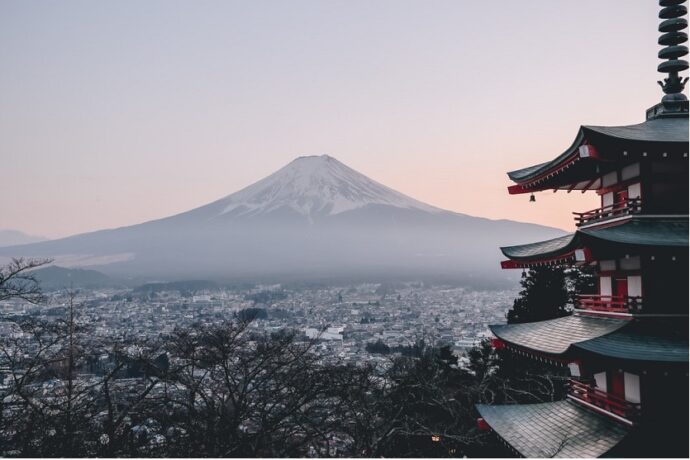
Sin comentarios